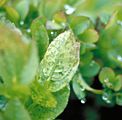Tolerance of freezing in plants
This is the normal way that cold adapted plants cope with freezing temperatures. Since ice formation will always start at the point of lowest solute concentration, freezing will commence at the outer cell wall surface (apoplast), with ice formation gradually filling the intercellular space, the cell wall itself, and the space between the cell wall and the increasingly shrunken protoplast. This mode of ice formation gradually withdraws water from the protoplast, which dehydrates.
- True frost resistance is a special form of dehydration (drought) resistance.
- It requires a cell membrane with a lipid layer permitting controlled water passage at very low temperature.
- It requires compounds in the cytoplasm which stabilise the membrane during deformation in the course of maximum dessication and which suppress ice formation in the protoplast (very high osmotic pressures induced by up to > 90 % water loss).
Freezing tolerance is not a constant. It varies with climatic conditions (acclimation) and phenological state of plants. The maximum freezing tolerance is a genetic feature.
| Average range of freezing tolerance in leaves of alpine plants | ||
|---|---|---|
| Type of plant | Summer (active) | Winter (dormant) |
| plants requiring snow cover in winter | -3 to -10 °C | -6 to -22 °C |
| plants which can survive in open places | -20 to -76(196) °C | |

